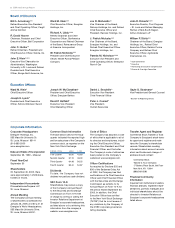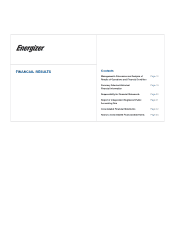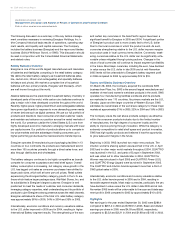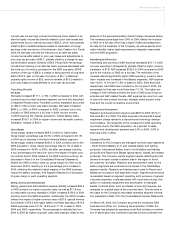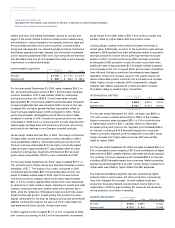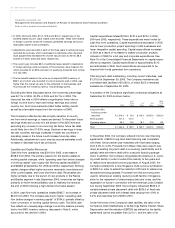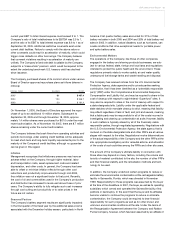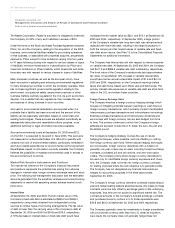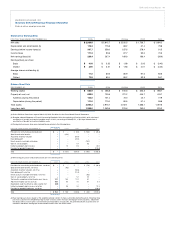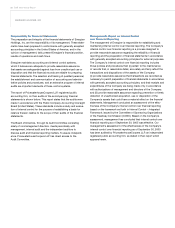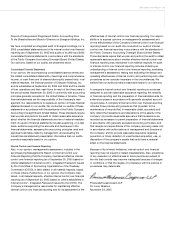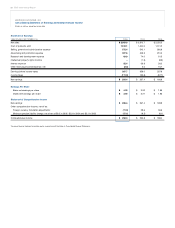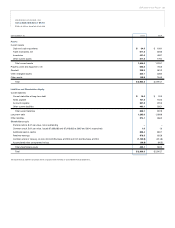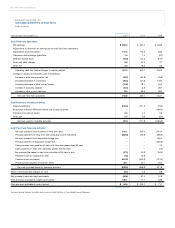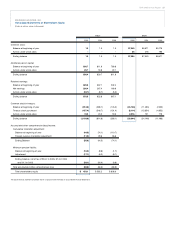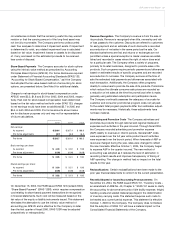Energizer 2005 Annual Report Download - page 19
Download and view the complete annual report
Please find page 19 of the 2005 Energizer annual report below. You can navigate through the pages in the report by either clicking on the pages listed below, or by using the keyword search tool below to find specific information within the annual report.
ENR 2005 Annual Report 17
investments. Capital structuring techniques are used to manage the
net investment in foreign currencies as necessary. Additionally, the
Company attempts to limit its U.S. dollar net monetary liabilities in
countries with unstable currencies.
Stock Price
Aportion of the Company’s deferred compensation liabilities is
based on the Company’s stock price and is subject to market risk.
The Company entered into a prepaid share option with a financial
institution to mitigate this risk as discussed in Note 15 to the
Consolidated Financial Statements. The change in fair value of
the prepaid share option is recorded in SG&A expense. Changes
in value of the prepaid share option should substantially mitigate
changes in the after-tax deferred compensation liabilities tied to
the Company’s stock price. Market value of the prepaid share
options was $20.4 and $22.1 at September 30, 2005 and 2004,
respectively. The change in fair value of the prepaid share option
for the year ended September 30, 2005 and 2004 resulted in
income of $5.4 and $8.8, respectively.
Business Realignment
Energizer continually reviews its battery and razor and blades busi-
ness model, including its product supply chain, sales, marketing
and administrative organizations. Such reviews may trigger business
realignment activities with potentially significant futurecharges to
earnings. In this regard, the Company is currently reviewing its
global supply chain complex for improvement opportunities and
may initiate activities during fiscal 2006, which may involve charges
to earnings in the future of up to $30.
Critical Accounting Policies
The Company identified the policies below as critical to its business
operations and the understanding of its results of operations. The
impact and any associated risks related to these policies on its busi-
ness operations is discussed throughout Management’s Discussion
and Analysis of Results of Operations and Financial Condition where
such policies affect the reported and expected financial results.
Preparation of the financial statements in conformity with generally
accepted accounting principles (GAAP) in the U.S. requires the
Company to make estimates and assumptions that affect the
reported amounts of assets and liabilities, disclosure of contingent
assets and liabilities and the reported amounts of revenues and
expenses. On an ongoing basis, the Company evaluates its estimates,
including those related to customer programs and incentives, bad
debts, inventories, intangible assets and other long-lived assets,
income taxes, financing operations, pensions and other postretirement
benefits, contingencies and acquisitions. Actual results could differ
from those estimates. This listing is not intended to be a compre-
hensive list of all of the Company’s accounting policies.
¨Revenue Recognition The Company’s revenue is from the sale of its prod-
ucts. Revenue is recognized when title, ownership and risk of loss passes
to the customer. Discounts are offered to customers for early payment and
an estimate of such discounts is recorded as a reduction of net sales in
the same period as the sale. Our standard sales terms are final and returns
or exchanges are not permitted unless a special exception is made;
reserves are established and recorded in cases where the right of return
does exist for a particular sale. The Company offers a variety of programs,
primarily to its retail customers, designed to promote sales of its products.
Such programs require periodic payments and allowances based on
estimated results of specific programs and are recorded as a reduction
to net sales. The Company accrues at the time of sale the estimated total
payments and allowances associated with each transaction. Additionally,
the Company offers programs directly to consumers to promote the sale
of its products. Promotions which reduce the ultimate consumer sale
prices are recorded as a reduction of net sales at the time the promotional
offer is made, generally using estimated redemption and participation
levels. The Company continually assesses the adequacy of accruals for
customer and consumer promotional program costs not yet paid. To the
extent total program payments differ from estimates, adjustments may
be necessary. Historically, these adjustments have not been material.
¨Pension Plans and Other Postretirement Benefits The determination of
the Company’s obligation and expense for pension and other postretire-
ment benefits is dependent on certain assumptions developed by the
Company and used by actuaries in calculating such amounts. Assumptions
include, among others, the discount rate, future salary increases and the
expected long-term rate of return on plan assets. Actual results that differ
from assumptions made are accumulated and amortized over future
periods and therefore, generally affect the Company’s recognized expense
and recorded obligation in futureperiods. Significant differences in actual
experience or significant changes in assumptions may materially affect
pension and other postretirement obligations. In determining the discount
rate, the Company uses the yield on high-quality bonds that coincides
with the cash flows of its plans’ estimated payouts. For the U.S. plans,
which represents the Company’s most significant obligations, the
CitiGroup yield curve is used in determining the discount rates.
Of the assumptions listed above, changes in the expected assets returnhave
the most significant impact on the Company’sannual earnings prospectively.
Aone percentage point decrease or increase in expected assets return would
decrease or increase the Company’s pre-tax pension expense by $6.6.
¨Valuation of Long-Lived Assets The Company periodically evaluates its
long-lived assets, including goodwill and intangible assets, for potential
impairment indicators. Judgments regarding the existence of impairment
indicators are based on legal factors, market conditions and operational
performance. Future events could cause the Company to conclude that
impairment indicators exist. The Company uses the discounted cash
flows method to determine if impairment exists. This requires manage-
ment to make assumptions regarding future income, working capital
and discount rates, which would affect the impairment calculation.
¨Income Taxes The Company estimates income taxes and the income tax
rate in each jurisdiction where it operates. This involves estimating taxable
earnings, specific taxable and deductible items, the likelihood of generating
sufficient future taxable income to utilize deferred tax assets, and possible
exposures related to future tax audits. To the extent these estimates
change, adjustments to income taxes are made in the period in which the
estimate is changed. Changes in such estimates for prior year tax accru-
als resulted in a reduction of income taxes of $10.6, $8.5 and $7.0 in 2005,
2004 and 2003, respectively.
¨Acquisitions The Company uses the purchase method that requires the
allocation of the cost of an acquired business to the assets acquired and
liabilities assumed based on their estimated fair values at the date of
acquisition. The excess of the cost of an acquired business over the fair



